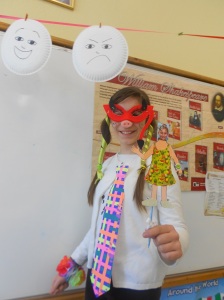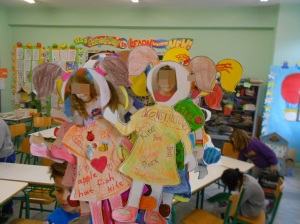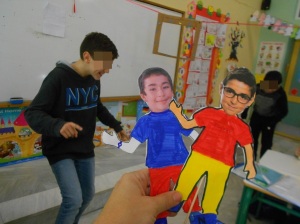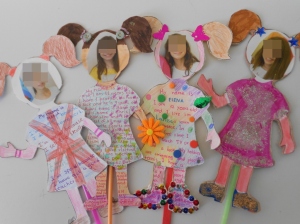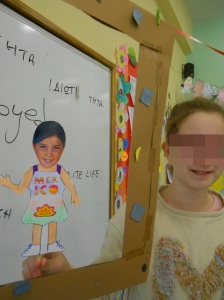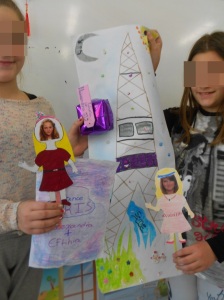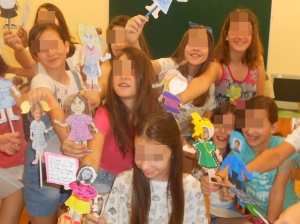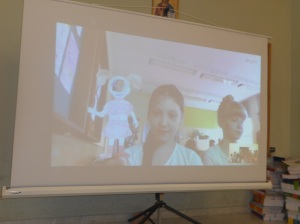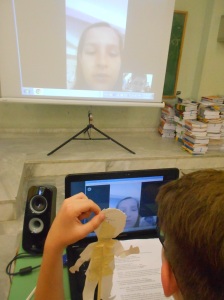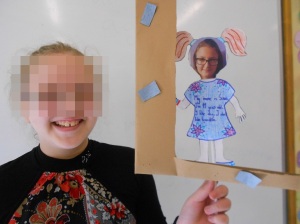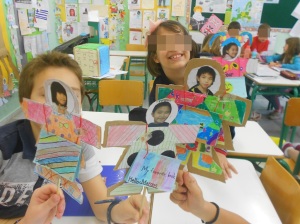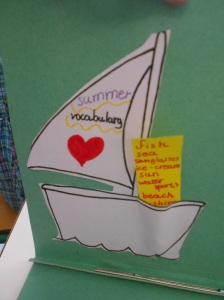Today, I am reposting Kathryn Harper‘s article on the OUP link below, which I have found highly interesting! Hope, you will find it as motivating, as I have.
I have actually used, almost all of the suggested activities below, in class, all these years…!
For those of you following my blog, it’s obvious that, I love using Puppets, in my classes!
Actually, I believe that, Puppets change the entire classroom, by creating more possibilities for creativity, collaboration, critical thinking, and curiosity. They give students a (sometimes silly) voice and put them in the role of creator. They can also be a co-teacher, a physical avatar, a learning partner, and even facilitate learning by subverting the ego.
Puppets are a great way to encourage and motivate your pre-primary learners when learning a new language.
Here, Kathryn Harper, gives her top ten tips for using a puppet in the classroom.
1) Greetings and routines: “Hello. How are you?”
Establishing predictable routines is extremely important in the pre-primary classroom to help with classroom management. With routines, children quickly get to understand what’s expected of them, giving them the confidence to learn and achieve more.
A great way to use the class puppet is for routines. The puppet can greet and say goodbye to the children when they come in or leave the class, and elicit information from them, for example, “How are you today?”
The children will be comfortable and interested in replying to the puppet, and even the shyest child will want to interact with it in this way.
By using the puppet regularly for specific activities such as ‘Reading time’ or ‘Goodbye time’, you can move from one activity to the next seamlessly, keeping your students motivated and engaged.
2) Creating affective conditions
One of the pre-conditions for learning is for children to feel comfortable, secure, and in a nurturing environment. The presence of a class puppet can help reinforce this ‘safe’, affectionate space.
Here’s how to create this space using your puppet:
- Puppets, particularly a soft one, can give cuddles to the children. This creates an instant warm reaction with the children.
- Children can express affection towards the puppet by stroking it, patting its head etc. This contact can be extremely important in breaking down barriers, relaxing the children, and enabling physical expression.
- The puppet can comfort children if they are sad, for example, they can sit with the puppet. The puppet keeps children comforted and includes them in the class.
- The puppet can be emotional when you can’t, for example, show anger or cry. This is a great way for children to learn about different emotions.
3) Using humour to animate the classroom
As a teacher, you know that getting and keeping the attention of a class full of little ones can be a challenge when it’s just you up at the front of the class. Having a class puppet can suddenly make everything more interesting for your students, and is a great way to animate your class. Used in the right doses, the puppet can keep the attention of your students in many ways:
- By doing funny or unusual things.
- By showing reactions or emotions that might not be acceptable.
- By creating a focus to an otherwise boring event.
- By interacting with you.
4) Being allowed to get things wrong
Learning from mistakes and helping children see the good side of getting things wrong is key for their development. The puppet can be a huge confidence booster to your students, by showing them that it’s perfectly normal to get things wrong. It can do this by:
- Showing the children that it doesn’t understand everything – and that’s alright!
- Making fun of itself when it doesn’t understand –taking the pressure off children to get things perfect first time.
- Letting the children play at being the teacher.
5) Modelling activities
When it comes to new activities and role plays, puppets can make the best partners. The puppet can attempt the role play and make a few mistakes. This shows students that it’s fine if they don’t get things right first time. Eventually, the puppet will complete the role play correctly and provide the perfect model for the children.
6) Acting out
One of the most effective and involving activities for children is acting out stories or situations. Of course the children could be the actors themselves, but if they use puppets, it liberates them and gives them greater creative licence. In particular, shy children can come alive using puppets as it takes the focus off them. What’s more, children with lower linguistic levels can be just as engaged with puppets because they can react visually through actions when they don’t have words.
7) Helping create stories or storytelling
Following on from number six, the next step is for children to create their own stories or follow on from an existing one. For this, you will need more than one puppet but you can easily get kids to bring in some of their cuddly toys, or make your own! When children tell their own stories, you really know they are engaged, their brains are working, and they have something to say.
This is a great activity to get the whole class participating. It can be very casual and short, or more involved and set up with props depending on your class size, the confidence of your students, or the learning outcomes you have set.
8) Being a target for activities
Activities are a lot more fun when a puppet is playing along. For example, if you are working on furniture vocabulary, you could play games such as ‘Where’s the puppet?’ – “He’s on the chair!” Or for classroom objects, you could play ‘What’s in the puppet’s bag?’ You can play games in which you pass the puppet around the class until someone says a particular word, and you could even play ‘Puppet says’ (instead of ‘Simon says’). The variations are endless. Have fun including the puppet in class games, and see your students’ participation soar!
9) The puppet as a a ‘prize’
The puppet is a tool for helping students learn how to behave in class, and as such, it can be used as a reward or a prize to incentivise good behaviour or hard work. Some ways you could use the puppet as a reward include:
- holding the puppet for the rest of the class
- leading the class in a song as ‘the puppet’
- saying ‘Goodbye’ to everyone as ‘the puppet’
Children will be proud to take responsibility for the puppet during the class, and know they must look after it carefully.
10) Making puppets and creating a persona
Making puppets can become a great cross-curricular activity in itself and develop students’ fine motor skills. Get the children to create puppets reflecting characters from their English coursebook or their favourite stories, reflecting themselves or their chosen imaginary characters. By investing with the actual making of these puppets, role play or storytelling will become a lot more personal to the students.
Puppet making can be very simple or more complex. You can make puppets out of socks or paper bags. Finger puppets can be made out of felt, wool, paper or other materials, or even stick puppets made from lollypop sticks. There a lots of other ways to make great puppets so have fun getting crafty with your students! Looking for some templates to help you get started? Here are some finger puppets featuring some of the much loved characters from OUP’s Show and Tell series!
Kathryn Harper has a background in ELT teaching in both France and Canada. She worked in publishing for 10 years as a grammar and reference editor (OUP), developing-world schools and ELT publisher (OUP and Macmillan), and ELT publisher for Latin America (Macmillan). She has written educational materials for the Middle East, Latin America, and Africa, and is one of the authors of the pre-primary course Show and Tell (OUP).
Here’s the OUP link:
https://oupeltglobalblog.com/2018/06/08/10-ways-use-puppets-elt/





















































